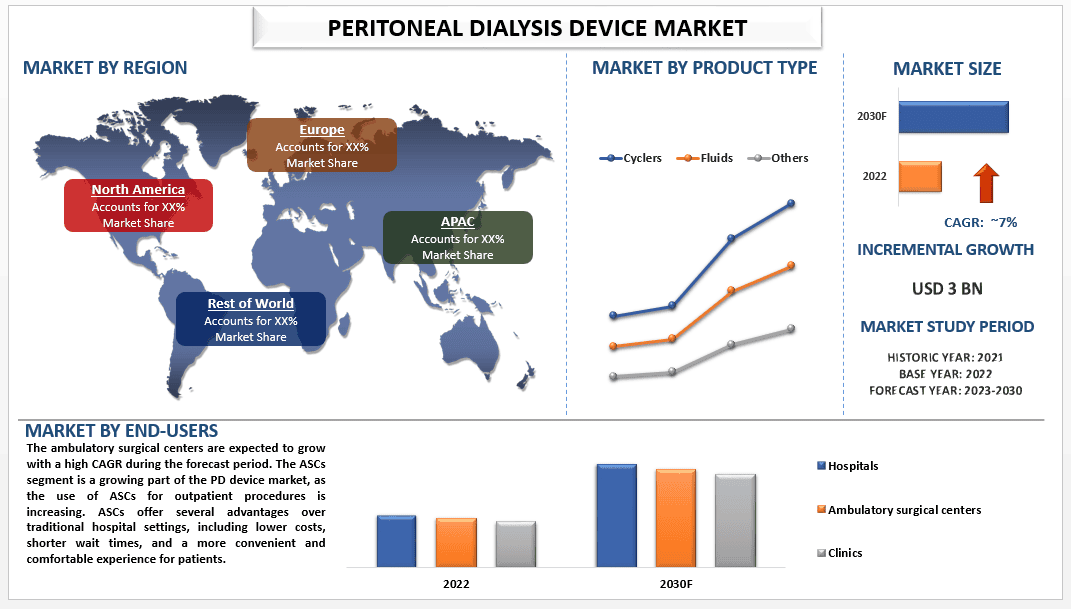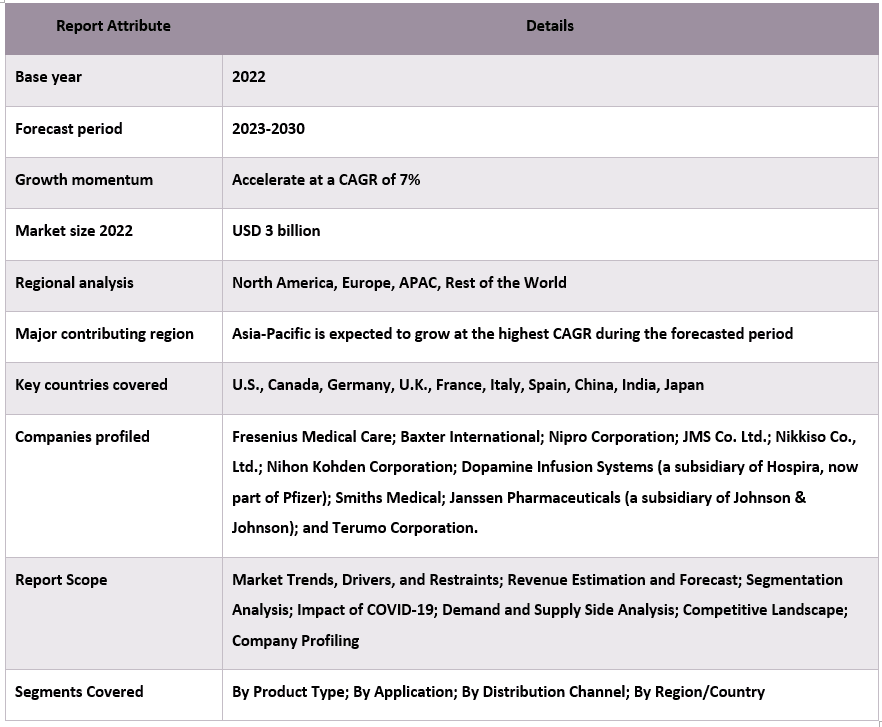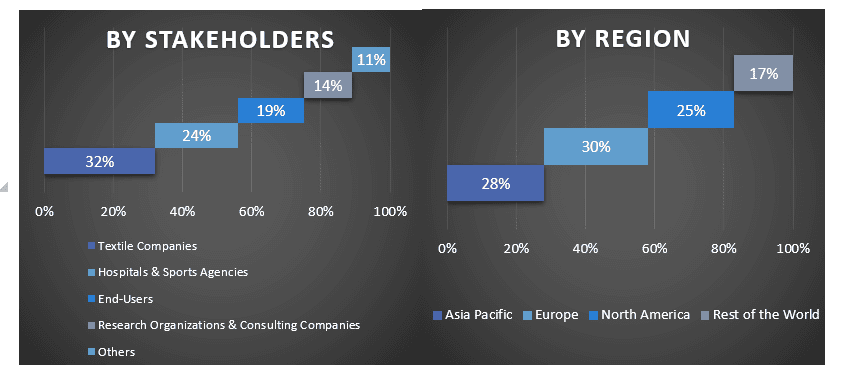- Home
- About Us
- Industry
- Services
- Reading
- Contact Us
Peritoneal Dialysis Device Market: Current Analysis and Forecast (2023-2030)
Emphasis on Product Type (Cyclers, Fluids, and Others); End User (Hospitals, Ambulatory Surgical Centers, and Clinics, and Region/Country

The Peritoneal Dialysis Device market was valued at USD 3 billion in the year 2022 and is expected to grow at a strong CAGR of around 6% during the forecast period (2023-2030). A peritoneal dialysis (PD) device is a medical device used to perform peritoneal dialysis, a treatment option for end-stage renal disease (ESRD). PD involves the use of a dialysis solution, which is infused into the peritoneal cavity, and the waste products that are filtered out of the blood by the peritoneal membrane are drained from the cavity. The PD device market is driven by the increasing prevalence of end-stage renal disease (ESRD) worldwide, as well as the growing demand for home dialysis options. PD is a preferred treatment option for many patients due to its flexibility and convenience, and as a result, the market for PD devices is expected to continue to grow in the coming years.
Some of the major players operating in the market include Fresenius Medical Care; Baxter International; Nipro Corporation; JMS Co. Ltd.; Nikkiso Co., Ltd.; Nihon Kohden Corporation; Dopamine Infusion Systems (a subsidiary of Hospira, now part of Pfizer); Smiths Medical; Janssen Pharmaceuticals (a subsidiary of Johnson & Johnson); and Terumo Corporation. Several M&As along with partnerships have been undertaken by these players to facilitate customers with hi-tech and innovative products/technologies.
Insights Presented in the Report
“Amongst product type, the fluids segment held a dominating share of the market in 2022”
Based on product type, the market is segmented into cyclers, fluids, and others. Amongst these, the fluids segment dominated the market in 2022. The fluids segment is a critical component of the PD device market, as the availability and quality of dialysis solutions can significantly impact the effectiveness and safety of PD treatments. There are several types of dialysis solutions available, including standard saline solutions, balanced solutions, and acid-based solutions.
“Amongst End-users, ambulatory surgical centers are expected to grow with high CAGR during the forecast period”
Based on the end-users, the market has been classified into hospitals, ambulatory surgical centers, and orthopedic clinics. Among these, ambulatory surgical centers are expected to grow with a high CAGR during the forecast period. The ASCs segment is a growing part of the PD device market, as the use of ASCs for outpatient procedures is increasing. ASCs offer several advantages over traditional hospital settings, including lower costs, shorter wait times, and a more convenient and comfortable experience for patients.
Peritoneal Dialysis Device Market Report Coverage

“Asia Pacific dominated the Peritoneal Dialysis Device market in 2022”
The APAC PD device market is driven by a number of factors, including increasing healthcare expenditure, aging populations, and the growing awareness of the benefits of PD. In addition, advancements in technology are also expected to drive the growth of the APAC PD device market, as new and improved PD devices become available.
Reasons to buy this report:
- The study includes market sizing and forecasting analysis validated by authenticated key industry experts.
- The report presents a quick review of overall industry performance at one glance.
- The report covers an in-depth analysis of prominent industry peers with a primary focus on key business financials, product portfolios, expansion strategies, and recent developments.
- Detailed examination of drivers, restraints, key trends, and opportunities prevailing in the industry.
- The study comprehensively covers the market across different segments.
- Deep dive regional level analysis of the industry.
Customization Options:
The global Peritoneal Dialysis Device market can further be customized as per the requirement or any other market segment. Besides this, UMI understands that you may have your own business needs, hence feel free to contact us to get a report that completely suits your requirements.
Table of Content
Research Methodology for the Peritoneal Dialysis Device Market Analysis (2023-2030)
Analyzing the historical market, estimating the current market, and forecasting the future market of the global Peritoneal Dialysis Device market were the three major steps undertaken to create and analyze the adoption of Peritoneal Dialysis Device in major regions globally. Exhaustive secondary research was conducted to collect the historical market numbers and estimate the current market size. Secondly, to validate these insights, numerous findings and assumptions were taken into consideration. Moreover, exhaustive primary interviews were also conducted, with industry experts across the value chain of the global Peritoneal Dialysis Device market. Post assumption and validation of market numbers through primary interviews, we employed a top-down/bottom-up approach to forecasting the complete market size. Thereafter, market breakdown and data triangulation methods were adopted to estimate and analyze the market size of segments and sub-segments of the industry pertains to. Detailed methodology is explained below:
Analysis of Historical Market Size
Step 1: In-Depth Study of Secondary Sources:
Detail secondary study was conducted to obtain the historical market size of the Peritoneal Dialysis Device market through company internal sources such as annual reports & financial statements, performance presentations, press releases, etc., and external sources including journals, news & articles, government publications, competitor publications, sector reports, third-party database, and other credible publications.
Step 2: Market Segmentation:
After obtaining the historical market size of the Peritoneal Dialysis Device market, we conducted a detailed secondary analysis to gather historical market insights and share for different segments & sub-segments for major regions. Major segments are included in the report as product type, application, and distribution channel. Further country-level analyses were conducted to evaluate the overall adoption of testing models in that region.
Step 3: Factor Analysis:
After acquiring the historical market size of different segments and sub-segments, we conducted a detailed factor analysis to estimate the current market size of the Peritoneal Dialysis Device market. Further, we conducted factor analysis using dependent and independent variables such as product type, application, and distribution channel of the Peritoneal Dialysis Device market. A thorough analysis was conducted for demand and supply-side scenarios considering top partnerships, mergers and acquisitions, business expansion, and product launches in the Peritoneal Dialysis Device market sector across the globe.
Current Market Size Estimate & Forecast
Current Market Sizing: Based on actionable insights from the above 3 steps, we arrived at the current market size, key players in the global Peritoneal Dialysis Device market, and market shares of the segments. All the required percentage shares split, and market breakdowns were determined using the above-mentioned secondary approach and were verified through primary interviews.
Estimation & Forecasting: For market estimation and forecast, weights were assigned to different factors including drivers & trends, restraints, and opportunities available for the stakeholders. After analyzing these factors, relevant forecasting techniques i.e., the top-down/bottom-up approach were applied to arrive at the market forecast for 2030 for different segments and sub-segments across the major markets globally. The research methodology adopted to estimate the market size encompasses:
- The industry’s market size, in terms of revenue (USD) and the adoption rate of the Peritoneal Dialysis Device market across the major markets domestically
- All percentage shares, splits, and breakdowns of market segments and sub-segments
- Key players in the global Peritoneal Dialysis Device market in terms of products offered. Also, the growth strategies adopted by these players to compete in the fast-growing market
Market Size and Share Validation
Primary Research: In-depth interviews were conducted with the Key Opinion Leaders (KOLs) including Top Level Executives (CXO/VPs, Sales Head, Marketing Head, Operational Head, Regional Head, Country Head, etc.) across major regions. Primary research findings were then summarized, and statistical analysis was performed to prove the stated hypothesis. Inputs from primary research were consolidated with secondary findings, hence turning information into actionable insights.
Split of Primary Participants in Different Regions

Market Engineering
The data triangulation technique was employed to complete the overall market estimation and to arrive at precise statistical numbers for each segment and sub-segment of the global Peritoneal Dialysis Device market. data was split into several segments & sub-segments post studying various parameters and trends in the areas of the p product type, application, and distribution channel in the global Peritoneal Dialysis Device market.
The main objective of the Global Peritoneal Dialysis Device Market Study
The current & future market trends of the global Peritoneal Dialysis Device market were pinpointed in the study. Investors can gain strategic insights to base their discretion for investments on the qualitative and quantitative analysis performed in the study. Current and future market trends determined the overall attractiveness of the market at a regional level, providing a platform for the industrial participant to exploit the untapped market to benefit from a first-mover advantage. Other quantitative goals of the studies include:
- Analyze the current and forecast market size of the Peritoneal Dialysis Device market in terms of value (USD). Also, analyze the current and forecast market size of different segments and sub-segments
- Segments in the study include areas of the product type, application, and distribution channel
- Define and analysis of the regulatory framework for the Peritoneal Dialysis Device industry
- Analyze the value chain involved with the presence of various intermediaries, along with analyzing customer and competitor behaviors of the industry
- Analyze the current and forecast market size of the Peritoneal Dialysis Device market for the major region
- Major countries of regions studied in the report include Asia Pacific, Europe, North America, and the Rest of the World
- Company profiles of the Peritoneal Dialysis Device market and the growth strategies adopted by the market players to sustain in the fast-growing market
- Deep dive regional level analysis of the industry
Related Reports
Customers who bought this item also bought










